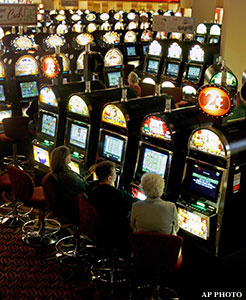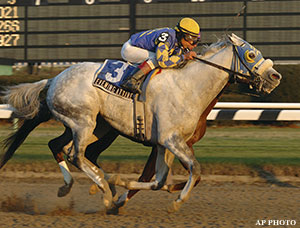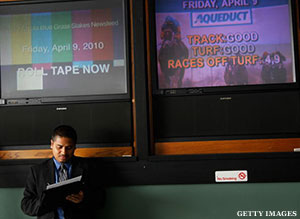
There are few friends here at Aqueduct Racetrack on a biting January day in Queens, just bettors sitting by themselves as the snowflakes begin to fall, talking to themselves about their next bet. A regular, a groundskeeper at a Queens cemetery, frustrated by his inability to make any money, blames the jockeys.
"I work in a cemetery," he screams in their direction after each race, "and I'll bury you myself."
The track is the last of a dying breed in New York State, one without the lucrative video lottery terminals (VLTs), the video slot machines that allow bettors to gamble on the outcome of a digital game. Inside Aqueduct's main concourse, having passed by the "Welcome to Aqueduct!" signs on the way in, a group of about 20 men, standing and holding the day's program, look up then down at the tote board featuring all the races. Up and down. Up and down. Up. Down.
It's rare to catch a smile at Aqueduct. Losing tickets litter the floor of the indoor grandstand, and by the end of the day, the floor will be completely covered with bits of failed bets.
The racing game is changing in New York. Soon, Aqueduct will join other thoroughbred and harness racetracks across the state in the VLT money pit, generating an estimated $300 million in annual tax revenue for the state, transforming the once-shoddy development into a destination site. In Albany, a coalition of the state's nine racetracks is pushing for a constitutional amendment to legalize commercial casinos, an idea that New York Gov. Andrew Cuomo is considering.
A sport that once packed three different tracks in New York City has become unrecognizable. The quality and volume of daily racing in the city and the state continues to suffer from years of financial indecision. John Ed Anthony, a prominent horse breeder and owner, once called the implementation of casinos at the racetrack, "the greatest threat to our industry in modern history."
"We've basically reached a point where the VLTs are running the show," said Bennett Liebman, the deputy secretary for gaming and racing under Gov. Cuomo, earlier this year.
But what would horse racing in New York look like if 9/11 never happened? While minor in scope, the circumstances that helped shape New York horse racing were about as predictable as a pull on a VLT lever.
On Sept. 10, 2001, an oversized "For Sale" sign hung from the entrance gate at Yonkers Raceway. The racetrack was a different place in 2001, not a destination site for Tri-State Area bettors, but simply a place to pass the time. If the track, owned by the Rooney Family of Pittsburgh Steelers lore, were to be sold, it would have become a mixed-use project, a combination of housing, shopping and offices.
And on Sept. 11, 2001, that changed.

Just more than a month later, the first New York VLT legislation came to fruition. The "For Sale" sign at Yonkers came down. In October 2006, the first VLTs were installed at Yonkers, signaling its arrival as one of the preeminent cash cows in New York racing.
"As harsh as the 9/11 experience was on multiple levels, it is the reason why New York racing is flourishing," says Chris Wittstruck, director of the Standardbred Owners Association. He adds: "If we didn't get this economic infusion sooner than later, we would have been done."
Following the attacks, Wall Street anxiety began to kick in, with legislators and businesses feeling the tremendous need for taxation and revenue replenishment. The state explored a myriad of avenues to blunt the short- and long-term financial blow the city would face in the aftermath. In addition to the $20.5 billion the city would receive in federal aid, New York State took on $500 million of New York City's prior debt. In the year following 9/11, the estimated one-year loss in New York City
reached a total of $17.5 billion in Gross City Product, according to the New York City Comptroller's records, roughly $1 billion in total tax revenue lost from the city in one year.
"The state was impacted because so much of its revenue comes from New York
City," says Jeff Ingber, author of "Resurrecting the Street: How U.S. Markets Prevailed After 9/11." "I think New York State took similar measures to what New York City did by raising long-term debt and seeking federal aid."
But the state legislature faced potentially gaping holes in the state and city budgets, and even more questions as to whether there would be more attacks in the coming days, furthering crippling the economy. One of the answers to stop the bleeding in the long term concerned the implementation of VLTs, an initiative that horsemen across New York State had been been pushing for (only for the legislature to mistake their prior pleas as a call for bacon, lettuce, and tomato sandwiches, Wittstruck jokes). The concept that gambling could never occur at a New York racetrack was forgotten about in one day: The images of tremendous tragedy and the need to sustain U.S. capitalism amid chaos overshadowing previous sentiments against gambling.
"I think on Sept. 10, 2001, if you had a gaming bill in the state legislature, it wouldn't have gone anywhere," says Timothy Capps, executive-in-residence for the equine industry program at the University of Louisville. "Two days later, they were willing to talk about it.
"I think certainly in New York there was a sense of, 'We don't know what's going to happen, we could see some serious declines in the economy.'"
However, the initial legislation and the tax rate for the horsemen, owners, and breeders was so poorly constructed, giving way to uneven tax revenue distribution, that it would be years before the first machines would be implemented. Breeders and owners hoping for enhanced purses to help breed and train a better quality of horse fled to surrounding states such as Delaware and West Virginia. The ramifications have been felt in the past decade: In 2009, the average purse per race in New York was $34,832, the lowest since 2000, according to the 2010 New York Fact Book on the thoroughbred industry.
"What was meant to give New York an economic boost after that fateful day has taken the better part of a decade to get online," says Lois Engel, who sits on the board of directors for New York Thoroughbred Breeders, referring to the backlog at Aqueduct. "Other neighboring states took New York's idea and ran with it, which helped send New York's breeding industry into a tailspin."

Horse racing has hitched its wagon to VLTs and that may or may not be a good thing. Even before New York State passed the first VLT resolution following Sept. 11, VLT revenue was beginning to increase U.S. thoroughbred purses. By 2009, almost 30 percent of U.S. thoroughbred purses were funded by casino gaming revenue at the 44 racinos operating in 12 states, according to Eugene Christiansen, CEO of Christiansen Capital Advisors, a New York-based independent research and consulting firm with expertise in horse racing. The basic premise for VLT revenue, which also goes toward funding the state's education initiatives, is to inject a
healthy percentage of earnings into the purses for horse racing. But this strategy -- "basically a subsidy," according to Christiansen -- has not led to any stimulation in the industry's consumer base. Presently, the industry's business model, heavily dependent on VLTs, and the lack of customer overlap between VLT and racing players represents a disconnect that, at its core, will continue to separate horse racing from the rest of the industry.
"While [VLT revenue] was good in a financial sense for the industry, it did nothing to create new horse players," Christiansen says. "Absolutely nothing."
It is mid-January in Yonkers, N.Y., roughly 112 months since that fateful day in Lower Manhattan. Much like any other day, the dead of winter can't stop the barrage of busloads that enter the main gate at Yonkers Raceway early in the day. Bettors at Empire City at Yonkers Raceway pull the lever over and over, hoping for a winner each time. Some are there for hours, even with the lights blinking at an annoyingly fast pace and the cartoonish sounds belching from the VLTs. There is one set of doors on the bottom level of the racino that lead toward the harness track, but only a few people venture out there on this brisk January night, most of them not
even noticing the racing is about the begin. The main seating area for fans is two flights up, but it is far from crowded. On the fourth floor, bettors hover around the simulcast screens, most standing and yelling the same way they do at Aqueduct. But here, in the VLT Promised Land, the bettors are forgotten amid the hustle and bustle from the VLT players beneath them.

Whether the industry would have inevitably passed VLTs even if 9/11 never
happened is debatable, but it's clear that the landscape would have seen a seismic shift, with thoroughbred and harness racetracks being forced to close or be sold.
"[Yonkers Raceway] wouldn't have been worth much," says Joe Kelly, a professor of business law at State College at Buffalo and co-editor of the Gaming Law Review.
A set of unique circumstances led the New York industry into its current
predicament, even if the horse racing industry wasn't designed to cash in on proposed legislation that had fallen on deaf ears through Sept. 10, 2001. New York State has leaned on the expansion of gambling to help advance its economic acumen in the years following the deepest loss of human life in the country's history.
Where this leaves the New York horse racing industry and its reliance on VLTs is anyone's guess. One of the better guesses comes from John Sabini, chairman of the New York Racing and Wagering Board, who understands that a greater influx of ideas needs to be implemented to make sure the industry doesn't rely on an idea that isn't necessarily the long-term answer -- one that was an inadvertent result of the state's need for a revenue fix.
"It's a maintenance drug," Sabini says of the VLTs earlier this year. "It gets us in competitions with other states. But at some point, where does the product stand on its own?"
Pull the lever and see.




